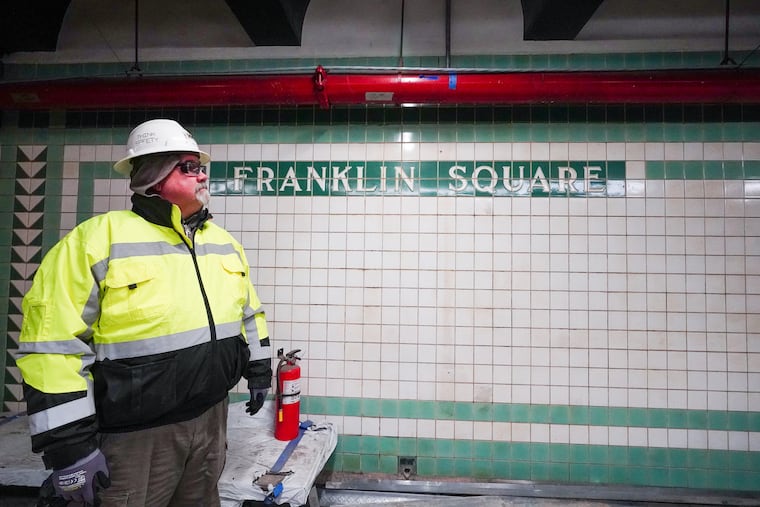PATCO’s ‘ghost’ station at Franklin Square is set to reopen in summer 2024 with a vintage look
The neon orange tiles are gone, but when the station reopens in 2024, classic details will remain.

Bit by bit, PATCO’s Franklin Square “ghost” train station is rising from the dead.
The 1930s green-and-white tiles that spell out its name and line the platform and concourses have emerged, luminous, from a coat of grime accumulated over decades.
“I had electricians coming out from underground looking like coal miners, covered in soot,” said senior project manager Ken Hanson of engineering company HNTB, recalling the original walls when work began in the summer of 2022.
Multiple power washings and solvents got the tile clean, though a patina of age is expected in places when the old transit stop reopens for service next year.
No passengers or trains in regular service have used Franklin Square Station since 1979 when it was closed and sealed for lack of riders. And it settled into the gloom as inbound trains from New Jersey blasted by with passengers barely glancing at a dimly lit equipment storage space and passageway for rail crews.
Now, there are signs of life.
A steel frame recently rose at the corner of North Seventh and Race Streets for the station’s headhouse, which will have walls of smoked glass speckled with dots, a pattern designed to save birds’ lives by steering them away from crashes.
The restoration is costing $30 million, including several years of prep work, paid for in part by $13.6 million in federal grants PATCO received in 2019.
It’s scheduled to open in late summer next year and to draw 1,300 to 1,500 daily riders. Neighborhoods within walking distance, such as Old City, are bristling with new condo buildings and residents. PATCO hopes they will become regular riders.
“Our board talked about this for years and, at the end of the day, believed that there was a tremendous amount of development that was beginning to happen here and that [the station] could spur more,” said John Hanson, chief executive of the Delaware River Port Authority, PATCO’s parent. (He is not related to HNTB’s Hanson, who is managing construction for the agency.)
“At the time, they were envisioning more commercial office growth, and that’s probably not going to happen now,” he said, with commercial vacancies increasing post-pandemic. But in the long run, John Hanson said he believes residential demand will continue.
There is developable property nearby, including the Roundhouse, the former headquarters of the Philadelphia Police Department, at Seventh and Race Streets. City officials are considering plans for the building.
Franklin Square’s 1930s history
Franklin Square Station opened in 1936 as the easternmost stop on the Camden-Philadelphia rail line operated at the time by the Philadelphia Rapid Transit Co., now part of SEPTA. It never stayed open for more than a few years at a time because it didn’t draw enough customers.
The station closed, then reopened when the Delaware River waterfront was bustling during World War II. With peacetime it shut down, only to be reactivated in 1953 when the commuter rail line was extended from Eighth and Market Streets to 15th and Locust Streets.
The rail line expanded more deeply into South Jersey, with the final station in Lindenwold. PATCO took over the expanded enterprise in February 1969, but Franklin Square Station didn’t figure into immediate plans.
It was renovated for $1.1 million and reopened in 1976 for the country’s Bicentennial. The stop lasted for three years.
Vintage tiles remain
On a recent afternoon, natural light poured into the underground construction site from stairways that not long ago went nowhere. The main stairs are already widened and spaced to make them easier for people with mobility issues to use. There’s a channel where the escalator will be. And a concrete elevator shaft.
To the possible disappointment of fans of 1970s kitsch, a fare collection area painted neon orange is gone.
But the original tiles from the Depression era are staying.
“What you see here, nothing more gets removed,” said Ken Hanson, who pointed to directional tiles at the foot of the main stairs, which he saved from a planned paint job. “We want to keep it as a novelty, a reminder.”